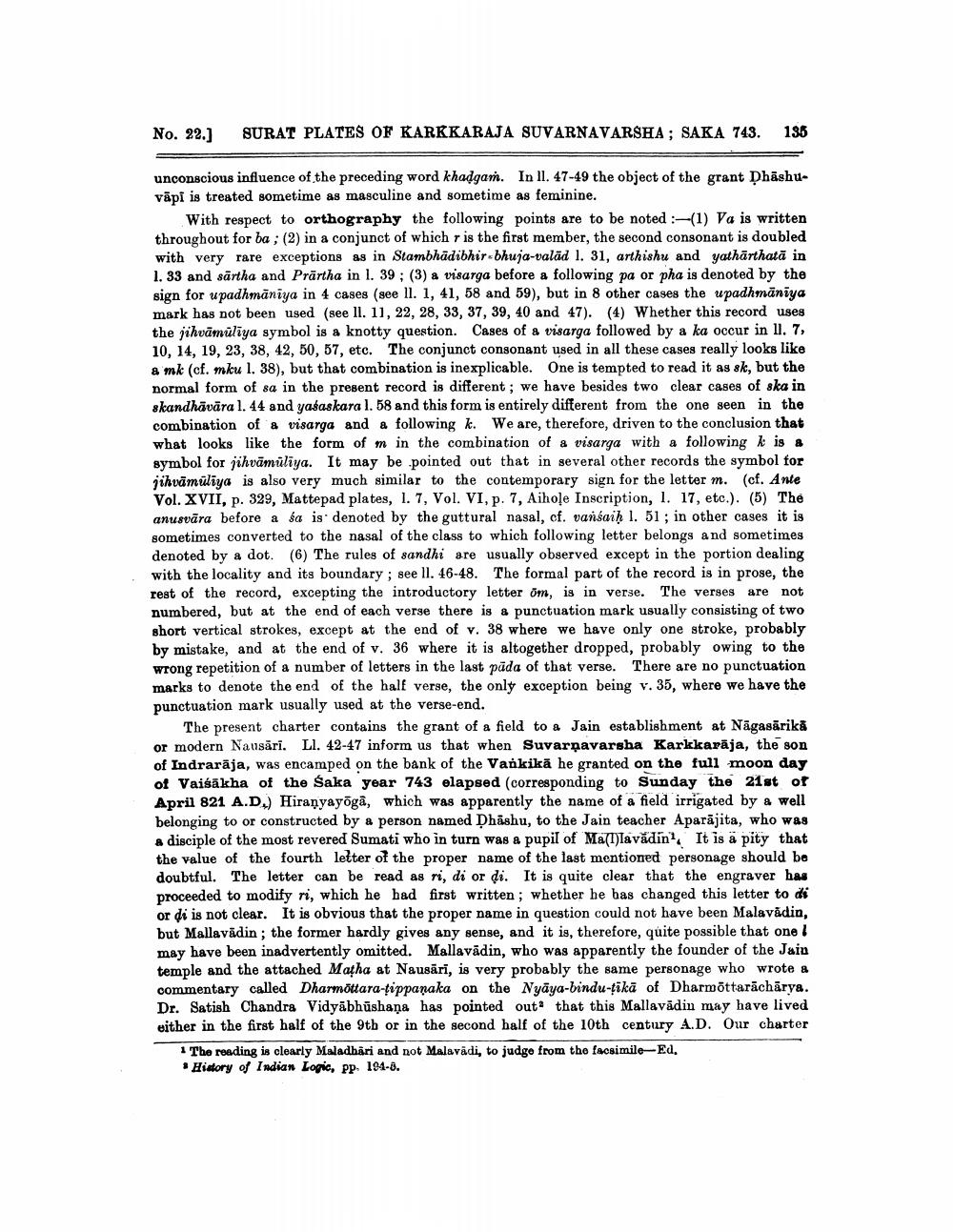________________
No. 22.]
SURAT PLATES OF KARKKARAJA SUVARNAVARSHA; SAKA 743. 136
unconscious influence of the preceding word khadgan. In II. 47-49 the object of the grant Dhäshuvāpi is treated sometime as masculine and sometime as feminine.
With respect to orthography the following points are to be noted :-(1) Va is written throughout for ba; (2) in a conjunct of which r is the first member, the second consonant is doubled with very rare exceptions as in Stambhādibhir-bhuja-valād 1. 31, arthishu and yathārthatā in 1. 33 and sārtha and Prärtha in l. 39; (3) a visarga before a following pa or pha is denoted by the sign for upadhmāniya in 4 cases (see ll. 1, 41, 58 and 59), but in 8 other cases the upadhmāniya mark has not been used (see 11. 11, 22, 28, 33, 37, 39, 40 and 47). (4) Whether this record uses the jihvāmülīya symbol is a knotty question. Cases of a visarga followed by a ka occur in II. 7, 10, 14, 19, 23, 38, 42, 50, 57, etc. The conjunct consonant used in all these cases really looks like & mk (cf.mku 1. 38), but that combination is inexplicable. One is tempted to read it as 8k, but the normal form of sa in the present record is different; we have besides two clear cases of ska in skandhāvāra l. 44 and yasaskara l. 58 and this form is entirely different from the one seen in the combination of a visarga and a following k. We are, therefore, driven to the conclusion that what looks like the form of m in the combination of a visarga with a following kis & symbol for jihvāmuliya. It may be pointed out that in several other records the symbol for jihvāmuliya is also very much similar to the contemporary sign for the letter m. (cf. Ante Vol. XVII, p. 329, Mattepad plates, 1. 7, Vol. VI, p. 7, Aihoļe Inscription, l. 17, etc.). (5) The anusvāra before a sa is. denoted by the guttural nasal, cf. vansaiḥ 1. 51; in other cases it is sometimes converted to the nasal of the class to which following letter belongs and sometimes denoted by a dot. (6) The rules of sandhi are usually observed except in the portion dealing with the locality and its boundary ; see ll. 46-48. The formal part of the record is in prose, the rest of the record, excepting the introductory letter om, is in verse. The verses are not numbered, but at the end of each verse there is & punctuation mark usually consisting of two short vertical strokes, except at the end of v. 38 where we have only one stroke, probably by mistake, and at the end of v. 36 where it is altogether dropped, probably owing to the wrong repetition of a number of letters in the last päda of that verse. There are no punctuation marks to denote the end of the half verse, the only exception being v. 35, where we have the punctuation mark usually used at the verse-end.
The present charter contains the grant of a field to a Jain establishment at Nāgasărikā or modern Nausäri. LI. 42-47 inform us that when Suvarṇavarsha Karkkarāja, the son of Indrarāja, was encamped on the bank of the Vaikikā he granted on the full moon day of Vaišākha of the Śaka year 743 elapsed (corresponding to Sunday the 21st of April 821 A.D.) Hiranyayoga, which was apparently the name of a field irrigated by & well belonging to or constructed by a person named Dhashu, to the Jain teacher Aparājita, who was a disciple of the most revered Sumati who in turn was a pupil of Mall)lavădin It is a pity that the value of the fourth letter of the proper name of the last mentioned personage should be doubtful. The letter can be read as ri, di or di. It is quite clear that the engraver has proceeded to modify ri, which he had first written ; whether he has changed this letter to di or di is not clear. It is obvious that the proper name in question could not have been Malavādin, but Mallavādin; the former hardly gives any sense, and it is, therefore, quite possible that one may have been inadvertently omitted. Mallavādin, who was apparently the founder of the Jain temple and the attached Matha at Nausāri, is very probably the same personage who wrote & commentary called Dharmöttara-tippanaka on the Nyāya-bindu-tikā of Dharmõttarāchārya. Dr. Satish Chandra Vidyābhūshana has pointed out that this Mallavādin may have lived either in the first half of the 9th or in the second half of the 10th century A.D. Our charter
1 The reading is clearly Maladhari and not Malavādi, to judge from the facsimile-Ed. * Hidory of Indian Logic, pp. 194-8.




